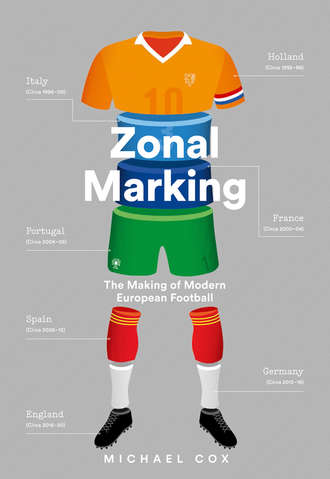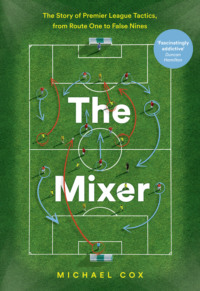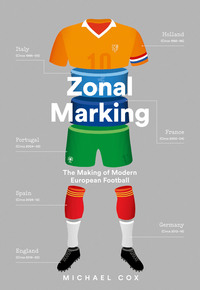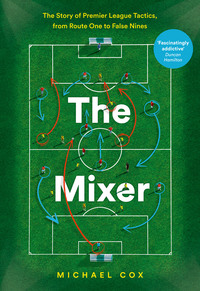
Полная версия
Zonal Marking
Cruyff, possibly more than anyone in the history of football, had very particular and influential ideas about goalkeepers, which is somewhat curious considering Cruyff was not a goalkeeper himself. Except for one thing – he was. Such was Cruyff’s all-round footballing ability, he kept goal for Ajax’s third team even after his first-team debut in 1964. Saving, catching and throwing were no problem for Cruyff, who had previously excelled at baseball as a youngster, showing potential as both pitcher and catcher. But for Cruyff, goalkeeping wasn’t about using your hands; it was ‘a question of vision’, and few could rival him in that respect. He believed the goalkeeper should act as an 11th outfielder, starting attacking moves and sweeping behind an advanced defensive line, and as a thoughtful and outspoken Dutch superstar Cruyff exerted a considerable influence on his managers’ tactical approach, acting as a catalyst for the development of the goalkeeper.
When Total Football changed the game at the 1974 World Cup, there was a perfect example of the Dutch goalkeeping approach. The incumbent number 1, PSV’s Jan van Beveren, was a fine shot-stopper revered across Europe, but he wasn’t a footballing goalkeeper. ‘I could not play football! I was a born goalkeeper: reflexes, jumping, strength,’ he admitted. But Cruyff was more concerned with speed, intelligence and passing, so he convinced manager Rinus Michels to drop Van Beveren and also overlook the highly rated Pieter Schrijvers of FC Twente. Holland instead fielded Jan Jongbloed, who played for the relatively obscure FC Amsterdam and had made a single appearance for the national team 12 years previously. Jongbloed was quick, comfortable sweeping behind his defence, good with his feet and therefore perfect for Total Football. The model for Dutch goalkeepers was thereby established, and upon the start of football’s modern era in 1992, the Dutch adjusted better than anyone. Dutch goalkeepers had always been, quite literally, several steps ahead of their European rivals.
In 1992 Ajax’s goalkeeper was Stanley Menzo, who was typical of many Ajax players during this period; he hailed from the former Dutch colony of Suriname, was a product of the club’s youth academy and was an all-round footballer rather than a specialist blessed with the traditional skillset for his position. Menzo was a footballing goalkeeper in Europe’s best footballing side, and was successful at Ajax because he was excellent with his feet. His spell as first-choice Ajax goalkeeper started under Johan Cruyff in 1985 and ended under Louis van Gaal in 1994 – he won the Eredivisie and European trophies under both, and unsurprisingly names them as the two greatest coaches he worked under. Both loved his footballing ability. Significantly, but not entirely unsurprisingly, Menzo offered plenty of experience in a different position. ‘I started as a sweeper, a central defender, but after less than a year I started to become a goalkeeper,’ he said. ‘Honestly, I could play goalkeeper but I could also play football. I was both, I could do both. And in the end … not I chose, but I became, a goalkeeper.’
This was in keeping with Ajax’s long-standing, forward-thinking goalkeeping approach introduced by Cruyff during his playing days, and when Cruyff was appointed Ajax manager in 1985, the athletic, speedy Menzo was promoted from back-up to succeed Hans Galjé as Ajax’s number 1. Menzo became renowned for his aggressive starting position and his excellent long throws, and was consistently showered with praise by Cruyff, who said he was Ajax’s most important player in the 1987 Cup Winners’ Cup because of his distribution. Menzo could play as an outfielder, Cruyff believed.
While Cruyff was stereotypically opinionated regarding the role of the goalkeeper, he also appreciated the requirement for a genuine specialist, and appointed the Netherlands’ first-ever goalkeeping coach, Frans Hoek, the most influential of the modern era. While also running a shop in the outskirts of Amsterdam that solely stocked goalkeeping paraphernalia, Hoek’s first pupil was Menzo, and the pair continued working together throughout the late 1980s and into Van Gaal’s reign as Ajax manager. The problem, however, was that Menzo was somewhat erratic in a traditional goalkeeping sense. The stubborn ideologist Cruyff was entirely forgiving of mistakes, declaring that Menzo’s footballing ability compensated for sporadic errors, but Van Gaal was more pragmatic. The final straw came when Ajax’s UEFA Cup defence was surprisingly ended by Auxerre in March 1993, with Menzo making a dreadful mistake, palming Pascal Vahirua’s inswinging corner into his own net. Van Gaal dropped Menzo and turned to Ajax’s back-up, the previously little-known Edwin van der Sar.
Van der Sar shared Menzo’s initial footballing experience – he originally played in defence, but when his youth team’s regular goalkeeper failed to turn up for a game, Van der Sar was handed the gloves purely because he was the tallest player in the side; he eventually grew to be 1.97 metres tall, enormous even by the standards of the Netherlands, the loftiest nation in the world. His early outfield experience ensured he became a significant goalkeeping revolutionary, as he adapted instinctively to the 1992 law changes. ‘The back-pass law changed my life, because I was already good with my feet,’ he recalled after his retirement.
‘We looked at what qualities an Ajax keeper should have, and Edwin already had most of them,’ said goalkeeping coach Hoek. ‘He had a good understanding of space around his goal and could play out to the defenders. That was difficult for many keepers, because most of them were “line-keepers” who stayed on their line and were primarily ball-stoppers. Also, he was tall and therefore had enormous range. He was calm, stable and a great foundation to build plays from. And importantly, he was ambitious and very coachable.’ As Jonathan Wilson outlines in his history of the goalkeeper, The Outsider, Van der Sar was ‘the first goalkeeper to operate as a genuine sweeper’.
That might surprise those who only witnessed the end of Van der Sar’s career, which continued into his 40s – by which point he’d split eight league titles and two Champions League successes between Ajax and Manchester United, and won a then-record 130 caps. Towards the end of his career, Van der Sar was less mobile and more of a classic goalkeeper; his brief, unhappy spell with Juventus saw him being encouraged to remain on his goal line, and at Manchester United he was also more conservative. But the early Ajax-era Van der Sar was renowned for his bravery and confidence in terms of positioning and distribution, and he became the obvious and outstanding role model for the following generation of goalkeepers. Indeed, Van der Sar was so influential that what was considered remarkable in his Ajax days became entirely commonplace by the time of his retirement.
‘One of the first to bring a new perspective was Edwin van der Sar, who played a lot with his feet and allowed the position to enter a new phase,’ Germany’s World Cup-winning goalkeeper Manuel Neuer later declared. ‘I was inspired by his style of play and enjoyed the philosophy of Ajax.’ Thibaut Courtois, David de Gea and Vincent Enyeama also cite him as a major inspiration. Of course, others attempted to play as a sweeper; at the 1990 World Cup, Colombia’s extravagant René Higuita was famously dispossessed well outside his area by Roger Milla, who converted into an empty net. But such goalkeepers were considered crazy, with Higuita, most notorious for his scorpion kick, famously nicknamed ‘El Loco’.
But Van der Sar wasn’t in any way loco. Van der Sar was boring, efficient and business-like. When he retired from playing, he didn’t choose coaching or punditry, but instead became Ajax’s CEO. When approached about writing an autobiography, he was worried he wouldn’t have enough material to fill the pages. ‘I’m sorry, I’m just not very rock and roll,’ he insisted. But his understated calmness was perfect for promoting the role of the ‘footballing goalkeeper’, demonstrating it was a logical, valuable undertaking rather than a self-indulgent experiment. When constructing passing moves, Ajax used their goalkeeper considerably more than other top-level European sides, because few teams were so committed to building from the back. A back pass to the goalkeeper was widely considered a last resort, especially as the goalkeeper would simply thump the ball downfield. But Ajax’s outfielders treated Van der Sar as one of their own, safe in the knowledge he would recycle possession.
Van der Sar was certainly better than his predecessor Menzo in a traditional goalkeeping sense, but he didn’t make many spectacular saves when compared with, for example, Peter Schmeichel or David de Gea, Manchester United’s other two most celebrated goalkeepers of the Premier League era. Van der Sar once explained his duty very simply as ‘stopping the balls that people expect you to save’. His only indulgence was taking a couple of penalties when Ajax were thrashing Eredivisie minnows – he had one saved against Sparta Rotterdam, then converted another against De Graafschap, although he was annoyed to subsequently lose his clean sheet in the final minute, making the score 8–1.
Van der Sar’s most impressive piece of ‘footballing’ skill came at the start of a famous goal Ajax scored away at MVV Maastricht in May 1995, shortly before their Champions League triumph. Defender Michael Reiziger found himself under pressure in the right-back zone, and his underhit back pass meant Van der Sar had to sprint laterally out of his goal, almost on the byline, to reach the ball. The accepted practice for goalkeepers in this situation is simple: smash the ball into the stands, shout obscenities at the appropriate defender and sprint back furiously towards goal. But not Van der Sar. Instead, he nipped in ahead of the opposition striker, sidestepping the challenge and playing a calm return pass to Reiziger, now beside the corner flag. What happened next demonstrated the importance of the goalkeeper’s coolness.
Reiziger dribbled past an opponent and passed forward to Litmanen, who fed Ronald de Boer. He evaded a tackle and passed left to Edgar Davids, who also slalomed past an opponent before knocking a through-ball into the path of the onrushing defender Danny Blind, who charged through on goal in the inside-right position, then knocked a square pass for left-winger Marc Overmars to convert at the far post. It was a remarkable team goal, the single greatest summary of Ajax’s footballing style under Van Gaal, and it all started with the composure of Van der Sar. Ajax’s attackers rushed to celebrate – but not with the goalscorer Overmars, who looked confused by the lack of teammates around him and awkwardly turned to hail the supporters on his own, but instead with the defensive section of the side, because they’d built the move from deep. A delighted Van Gaal emerged from his dugout with enthusiastic applause for a wonderful team goal. This was Ajax all over: forwards dropping deep, defenders running through on goal, rapid passing and, more than anything else, a footballing goalkeeper.
When Ajax won the Champions League, a watching Cruyff suggested that their key player was Van der Sar. Cruyff had been determined to introduce the Dutch goalkeeping model at Barcelona, but was frustrated with the performances of Andoni Zubizarreta. In terms of character, ‘Zubi’ could be likened to Van der Sar; he was hugely professional and statesmanlike, won a then-record 126 caps for Spain and later became Barca’s director of football. But in a goalkeeping sense Zubizarreta was distinctly old-school, happily remaining on his line, and Cruyff frequently criticised his lack of technical skills, which became a more obvious issue after the back-pass change. ‘Cruyff hasn’t changed me as a goalkeeper, but he’s changed my position,’ said Zubizarreta, which rather summed it up. Cruyff told him to act as a sweeper, yet at heart he was a pure shot-stopper, a ‘serious, reliable type of keeper’, in the Basque’s own words. Cruyff deployed him in midfield during training matches, desperate to improve his confidence in possession.
Zubizarreta lasted until 1994, before Cruyff turned to long-serving back-up Carles Busquets, father of future Barcelona midfielder Sergio. He was considerably more receptive to Cruyff’s tactics, playing miles off his line with typically mixed results. His first major appearance for Barcelona came when Zubizarreta was suspended for the 1991 European Cup Winners’ Cup Final, a 2–1 defeat to Manchester United, and was characterised by three major errors. First, Busquets raced outside his box towards a high ball, got nowhere near it and United’s Lee Sharpe volleyed narrowly wide of an empty net. Next, he was caught in no-man’s land for United’s opener, half-coming to claim a long free-kick before belatedly changing his mind. Steve Bruce headed over him, and former Barca striker Mark Hughes smashed in. Hughes doubled United’s lead seven minutes later, when he received a through-ball and immediately encountered Busquets 25 yards out of his goal, making a desperate sliding tackle. Hughes rounded him and again fired into an empty net.
Cruyff invested huge faith in Busquets. He was relatively short for a goalkeeper, at 1.81 metres, but was incredibly confident in possession and loved playing chipped passes over opposition attackers to his teammates. For most observers’ tastes, however, he was still incredibly haphazard. Shortly after replacing Zubizarreta as number 1, he made a characteristic error for the decisive goal in a shock 2–1 defeat at Gothenburg, charging off his line to intercept a long ball. Approaching the edge of his box, and unsure whether to head or punch, he did neither and Jesper Blomqvist, a winger hardly renowned for his aerial prowess, headed into the empty goal. This was typical of Busquets’ style, and the type of mistake the great Zubizarreta would never have made. More significantly, Busquets’ footballing skills were far from flawless and he was caught in possession rather too often. Even his attire prompted nerves, as he insisted on wearing long tracksuit bottoms, and when combined with the muddy goalmouths of this era, meant he looked too scruffy to inspire much confidence.
Journalists constantly linked Cruyff with a move for Van der Sar, to which Cruyff would diplomatically respond by pointing out that he didn’t have any slots left for foreign players. Besides, he forgave errors from footballing goalkeepers, believing that subtler positive contributions from sweeping and distributing compensated for the odd cheap concession. This became the mantra at Barcelona, and Busquets’ approach was considered so important that he later became the club’s goalkeeping coach, mentoring the likes of Pepe Reina and Víctor Valdés, and ensuring that Cruyff’s vision of a footballing goalkeeper remained integral to the Barcelona way.
There’s one final, forgotten Barcelona goalkeeper from this period who deserves belated recognition: Jesús Angoy. Another sweeper-keeper from Barcelona’s academy, he played just nine La Liga games between 1991 and 1996, largely without distinction, serving as back-up to Zubizarreta and then Busquets. But for two non-footballing reasons he is significant: first, he was married to Cruyff’s daughter Chantal, suggesting that the Cruyffian affection for footballing goalkeepers was somehow genetic. When Chantal gave birth, the beaming new grandfather Johan told the media that the newborn ‘has got big feet and big hands – the feet are for playing football and the hands are for picking up his wages’, with not even a passing thought that the hands might be useful for following his father into goalkeeping. Second, Angoy departed Barca in 1996 at the same time as Cruyff, but stayed in the city to continue his playing days over at the Olympic Stadium. Busquets didn’t move to Barca’s city rivals Espanyol, however; he switched sports and signed for NFL Europe side Barcelona Dragons. You might think this would be a natural transition for a goalkeeper, as American football is all about catching and throwing, but Angoy was actually the Dragons’ placekicker – and a very good one. He ended his second career as the second-highest points scorer in the history of NFL Europe, and turned down a transfer to the Denver Broncos because he wanted to remain in Barcelona with Chantal. Even in a sport that overwhelmingly involves using your hands, the former Barca goalkeeper specialised in the role that involves using your feet. His father-in-law presumably approved.
Playing out from the back was not, of course, solely about goalkeepers being comfortable in possession, and Dutch football placed great emphasis on defenders who offered, in Van Gaal’s words, ‘more than just defensive skills’. English football supporters were stunned when former Ballon d’Or winner Ruud Gullit, a world-class attacking midfielder, signed for Glenn Hoddle’s Chelsea in 1995 and promptly declared his intention to play as a sweeper, the position he’d played in his teenage years. ‘As a central defender I could move into midfield and would dash from there into an attacking position,’ he said. But the experiment lasted only a couple of months at Chelsea, because Gullit’s teammates simply weren’t on the same wavelength. ‘I would take a difficult ball, control it, make space and play a good ball in front of the right-back,’ Gullit recalled. ‘Except, he didn’t want that pass. Eventually, Glenn said to me, “Ruud, it would be better if you do these things in midfield.”’ The Dutch were well ahead of the game.
This had been a crucial feature of Total Football in the 1970s: defenders bursting forward when opportunities arose, with midfielders and attackers providing cover by dropping back. To make this worthwhile, however, the Ajax and Holland sides of the 1970s required defenders to be genuinely good footballers, capable of using their freedom to provide decisive contributions in the final third. Because of the importance of pressing, meanwhile, they also needed to offer speed, to play in a high defensive line and cover the space in behind.
When the Dutch adopted this policy during the 1970s it was genuinely revolutionary. Their defensive leader was Ajax’s Ruud Krol, a gloriously complete footballer who possessed the three qualities Dutch defenders would come to be renowned for – intelligence, speed and ball-playing ability. He read the game beautifully, swept up behind his fellow defenders and knocked long, diagonal balls to the wingers, sometimes doing all three in the same move. He was the only defender aside from the legendary Bobby Moore and Franz Beckenbauer to be voted into the top three of the Ballon d’Or in the 1970s, such was his impact on club and country, and he also provided the most concise summary of the Dutch approach to defending. ‘We looked to keep our opponent on the halfway line,’ he said. ‘Our standpoint was that we were not protecting our own goal – we were attacking the halfway line.’
Krol played left-back during Holland’s run to the 1974 World Cup Final, and his three defensive colleagues were also particularly attack-minded. Right-back Wim Suurbier, also of Ajax, was renowned more for his speed and stamina than his defensive ability, and constantly charged up the wing. In the middle, Holland converted Feyenoord’s Wim Rijsbergen from a right-back into a centre-back, and most significantly redeployed Ajax’s Arie Haan, a reliable midfielder, as the side’s fourth defender, although he had never previously played in defence. It’s also telling that the only two significant foreigners who turned out for Ajax during this period, Yugoslavian Velibor Vasović and German Horst Blankenburg, both played the physical, old-school hardman role, because Ajax simply didn’t produce that kind of defender themselves. ‘The foreign players brought something different,’ Cruyff acknowledged of the 1970s Ajax side. That kind of statement in England or Italy would be about foreigners bringing flair, but in the Netherlands it was about foreigners bringing fight.
By the time Cruyff’s and Van Gaal’s sides were dominating Europe in the 1990s, both were determined to promote the concept of the ball-playing defender, helped by the back-pass reform. Cruyff continued to talk about the importance of attacking the halfway line rather than defending the goal even after his retirement, complaining about ‘defenders running back towards their own goal when they lose the ball, rather than moving forward to put pressure on the players in possession’. His Barcelona side, more than any other team of the 1990s, attempted to play in the opposition half.
Such was the emphasis on ball-playing defenders, Van Gaal referred to them using a word previously reserved for attacking midfielders. ‘In modern soccer the players in the middle of the back four – the numbers 3 and 4 – have really become the playmakers,’ he said. ‘That’s why Danny Blind and Frank Rijkaard were so important to Ajax. The number 10 certainly can’t be called a playmaker because the space in which he operates is too restricted … today’s playmakers are to be found in the centre of the back four. This means, of course, you can no longer deploy the old-fashioned, solid type of player in these positions. You have to use technically and tactically gifted players like Blind and Rijkaard.’ Blind, Ajax’s captain, had played alongside Van Gaal for seven years at Sparta Rotterdam and was a calm, technically gifted footballer. But his defensive partner Rijkaard was the real star, hailed by Cruyff in his autobiography as ‘one of the best all-round footballers I’ve ever seen – he could defend with the best of them, he organised the midfield and he still had scoring potential. All of that in one person, who also had the right mentality and a good set of brains.’
Rijkaard was a curious, reserved figure constantly suffering some form of identity crisis. He was considered a thug by many for his quite literal 1990 World Cup spat with Rudi Völler, but was actually among the most amiable footballers around. He appeared a natural leader, but when Ajax manager Cruyff wanted him to become more involved in off-field duties, Rijkaard stormed out and refused to play under him again. He became a celebrity by virtue of his footballing ability, yet he found fame suffocating. He later became a successful coach, winning the Champions League with Barcelona in 2006, but walked away from management at 50, saying, ‘I don’t see myself as an authentic coach. I’ve done something for about 16 years which isn’t a match for me.’ But, most crucially in this context, Rijkaard was an outstanding defender who didn’t just want to defend.
This was nothing new for Dutch defenders, of course, but Rijkaard’s case was particularly extreme. He emerged from Ajax’s academy and became an outstanding, forward-thinking defender, partnering Ronald Koeman at Euro 88 and finishing third in that year’s Ballon d’Or voting. While Dutchmen were accustomed to Rijkaard’s attacking quality, other managers appeared surprised. ‘This is the best central defender I’ve seen in the last few years,’ raved Argentina manager Carlos Bilardo. ‘He wins everything in the air, he marks perfectly, reads the game well, has a great long pass and a great shot. He is the perfect defender, born for today’s game.’ Ireland boss Jack Charlton repeated the praise. ‘He can do everything! In England he would be worth gold. We hardly have any like him, a player who can defend and attack brilliantly.’
Rijkaard moved to AC Milan in 1988, and because Arrigo Sacchi had created the most formidable defensive quartet of that era – Mauro Tassotti, Franco Baresi, Alessandro Costacurta and Paolo Maldini – Rijkaard was deployed in midfield alongside another future Champions League-winning manager, Carlo Ancelotti. This came to be Rijkaard’s established position; he won the 1989 European Cup from midfield and was again voted third in the Ballon d’Or, and then helped Milan retain the European Cup by scoring the only goal in the final, breaking forward from midfield, receiving a through-ball from Marco van Basten and finishing coolly. Rijkaard was now a box-to-box midfielder. But for Holland he was fielded as a central defender at the 1990 World Cup, with the midfield based around the underperforming Ruud Gullit, his Milan teammate and childhood friend. Being deployed at centre-back frustrated Rijkaard and contributed to his decision to quit the national side. He wanted to be the playmaker, not a man-marker, and only returned to international duty when promised a midfield role.








